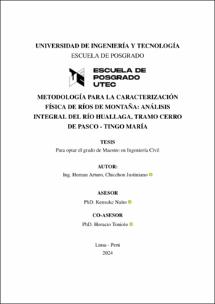Mostrar el registro sencillo del ítem
Metodología para la caracterización física de ríos de montaña: análisis integral del río Huallaga, tramo Cerro de Pasco - Tingo María
| dc.contributor.advisor | Naito, Kensuke | |
| dc.contributor.advisor | Toniolo, Horacio | |
| dc.contributor.author | Chicchon Justiniano, Hernan Arturo | |
| dc.date.accessioned | 2024-03-19T19:39:26Z | |
| dc.date.available | 2024-03-19T19:39:26Z | |
| dc.date.issued | 2024 | |
| dc.identifier.citation | Chicchon Justiniano, H. A. (2023). Metodología para la caracterización física de ríos de montaña: análisis integral del río Huallaga, tramo Cerro de Pasco - Tingo María [Tesis de Maestría, Universidad de Ingeniería y Tecnología]. Repositorio Institucional UTEC. https://hdl.handle.net/20.500.12815/358 | es_PE |
| dc.identifier.uri | https://hdl.handle.net/20.500.12815/358 | |
| dc.description.abstract | Esta investigación analiza los primeros 250 kilómetros del río Huallaga en Perú, enfocándose en su geomorfología, sedimentología, hidráulica e hidrología. Se caracterizaron el agua y los sedimentos, destacando patrones estacionales de caudal y transporte de sedimentos en periodos de avenidas. Se descubrió un importante aporte de sedimentos de afluentes y quebradas en meses secos, desafiando la comprensión tradicional de los procesos sedimentarios en ríos de montaña. Este aspecto es esencial para la gestión hidráulica y la planificación ambiental, enfatizando la importancia de aportes extraordinaria de sedimentos y como influye esto en la morfología fluvial. La investigación utilizó técnicas no intrusivas como granulometría óptica y velocimetría de imágenes de partículas a gran escala (LSPIV), proporcionando datos detallados sobre sedimentos y flujos. Estos métodos fueron clave para entender la morfología del lecho y la dinámica de transporte de sedimentos, cruciales en la conservación de ecosistemas fluviales y la mitigación de riesgos. El enfoque hidrológico e hidráulico ofreció comprensión sobre las respuestas del río a diversas condiciones, crucial para el diseño de estructuras hidráulicas eficientes. Este estudio multidisciplinario no solo es relevante para Perú, sino también para la gestión de ríos de montaña en general. La metodología integrada representa un avance en investigación fluvial y una base para estudios futuros y la gestión sostenible de ecosistemas fluviales. | es_PE |
| dc.description.abstract | This research analyzes the first 250 kilometers of the Huallaga River in Peru, focusing on its geomorphology, sedimentology, hydraulics, and hydrology. Both water and sediments were characterized, highlighting seasonal patterns of flow and sediment transport during flood periods. A significant contribution of sediments from tributaries and ravines during dry months was discovered, challenging the traditional understanding of sedimentary processes in mountain rivers. This aspect is essential for hydraulic management and environmental planning, emphasizing the importance of extraordinary sediment contributions and their influence on fluvial morphology. The study employed non-intrusive techniques such as optical granulometry and large-scale particle image velocimetry (LSPIV), providing detailed data on sediments and flows. These methods were key to understanding the riverbed morphology and the dynamics of sediment transport, crucial in the conservation of fluvial ecosystems and risk mitigation. The hydrological and hydraulic approach offered an understanding of the river’s responses to various conditions, essential for the design of efficient hydraulic structures. This multidisciplinary study is not only relevant for Peru but also for the management of mountain rivers in general. The integrated methodology represents an advancement in fluvial research and a foundation for future studies and sustainable management of fluvial ecosystems. | es_PE |
| dc.description.uri | Tesis | es_PE |
| dc.format | application/pdf | es_PE |
| dc.language.iso | spa | es_PE |
| dc.publisher | Universidad de Ingeniería y Tecnología | es_PE |
| dc.rights | info:eu-repo/semantics/openAccess | es_PE |
| dc.rights.uri | http://creativecommons.org/licenses/by-nc-nd/4.0/ | |
| dc.source | Repositorio Institucional UTEC | es_PE |
| dc.source | Universidad de Ingeniería y Tecnología - UTEC | es_PE |
| dc.subject | Sedimentos fluviales | es_PE |
| dc.subject | Hidrología | es_PE |
| dc.subject | Ríos amazónicos | es_PE |
| dc.subject | Diseño hidrológico | es_PE |
| dc.subject | LSPIV | es_PE |
| dc.subject | Fluvial sediments | es_PE |
| dc.subject | Hydrology | es_PE |
| dc.subject | Amazonian rivers | es_PE |
| dc.subject | Hydrological design | es_PE |
| dc.subject | LSPIV | es_PE |
| dc.title | Metodología para la caracterización física de ríos de montaña: análisis integral del río Huallaga, tramo Cerro de Pasco - Tingo María | es_PE |
| dc.title.alternative | Methodology for the physical characterization of mountain rivers: comprehensive analysis of the Huallaga river, section from Cerro de Pasco to Tingo María | es_PE |
| dc.type | info:eu-repo/semantics/masterThesis | es_PE |
| dc.subject.ocde | https://purl.org/pe-repo/ocde/ford#2.01.01 | es_PE |
| dc.publisher.country | PE | es_PE |
| thesis.degree.discipline | Maestría en Ingeniería Civil | es_PE |
| thesis.degree.grantor | Universidad de Ingeniería y Tecnología. Escuela de Posgrado | es_PE |
| thesis.degree.level | Maestría | es_PE |
| thesis.degree.name | Maestro en Ingeniería Civil | es_PE |
| renati.advisor.orcid | https://orcid.org/0000-0001-8683-0846 | es_PE |
| renati.advisor.orcid | https://orcid.org/0000-0002-6205-6128 | es_PE |
| renati.advisor.pasaporte | TT1752164 | |
| renati.advisor.pasaporte | 674611658 | |
| renati.author.dni | 71197020 | |
| renati.author.orcid | https://orcid.org/0000-0001-8513-1955 | es_PE |
| renati.discipline | 732999 | es_PE |
| renati.juror | Mantari Laureano, José Luis | |
| renati.juror | Rau Lavado, Pedro | |
| renati.juror | Naito, Kensuke | |
| renati.level | http://purl.org/pe-repo/renati/level#maestro | es_PE |
| renati.type | http://purl.org/pe-repo/renati/type#tesis | es_PE |





